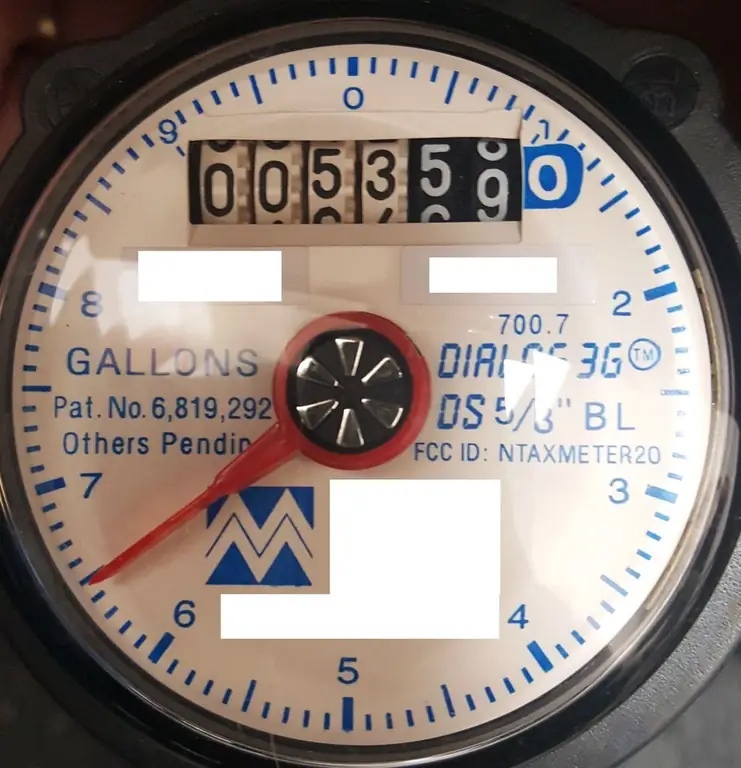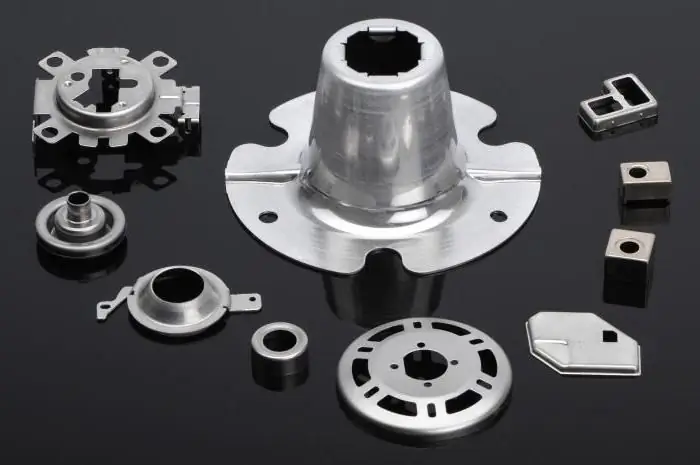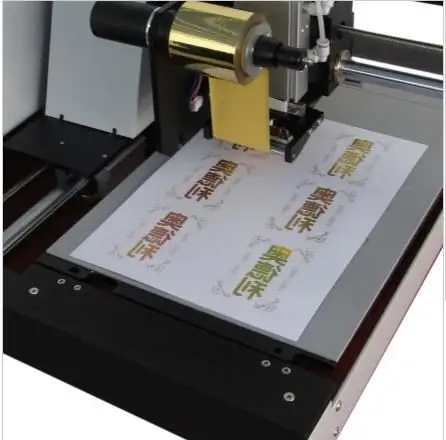2025 Author: Howard Calhoun | [email protected]. Last modified: 2025-01-24 13:10:31
Foil stamping is mainly used to give individuality and originality to souvenirs and gift printing products. They decorate business cards, postcards, folders, notebooks, labels, stickers, bags, leather products, etc. in this way. There are several ways to print with foil, which differ in the method and material of application. Technologically, embossing is not a particularly complicated procedure. You can decorate any souvenirs in this way even at home.
Foil Stamping Methods
You can make a similar decor with your own hands in two ways:
- using a laminator;
- iron.
Next, let's look at how embossing is done using these technologies, in more detail.

How to apply a pattern using a laminator
To print in this case, you will need a laser printer in addition to a laminator. It is better if it is not full-color, but ordinary. Concerninglaminator, then you should purchase a model with a very high compression force. You will also need toner sensitive foil. If desired, you can use both matte or glossy, and holographic.
Paper is best to take simple. Textured or special decorative for embossing at home are not very suitable. When using such material, the drawing will turn out to be sloppy and ugly. In the recesses of this type of paper, the metal simply will not stick.

Foil stamping using a laminator is done as follows:
- Find a beautiful vector pattern or ornament. You can also write in some program, for example in the same Photoshop, the appropriate text in the original font. It is only desirable that it is not too thin.
- Print the picture on the printer.
- Place a sheet with a pattern or lettering on the table and cover it with metallic foil of any color.
- Place another sheet of blank paper on top of it.
- Run the resulting "pie" through the laminator. Thin foil will definitely stick to the pattern. If the pattern turns out to be sloppy and intermittent, the procedure can be repeated. Run the sheets through the laminator until a satisfactory result is obtained.
Material from the sheet must be removed carefully, slowly.
Foil stamping at home with an iron
Of course, not every household has a laminator. This device is inexpensive, but buying it in order to dobeautiful embossing, absolutely not necessary. You can use a regular iron for ironing for this purpose. With regard to the inscription or pattern, the procedure in this case will be exactly the same as when embossing with a laminator.

The printed sheet should be placed face up on a hard surface. The foil is superimposed on it with the wrong side down. That is, the shiny side should be on top.
The iron is set to minimum heat. On the foil they need to drive as carefully as possible. If it does not stick to the pattern, increase the heat setting a little. It is necessary to iron the foil for about 2 minutes, until the thin metal sticks to the heated paint. Do not remove the foil from the sheet immediately. Wait for it to cool down.
Embossed leather
Using the technology that will be presented below, you can decorate almost any leather product: a bag, boots, wallet, notebook, belt, etc. To complete the drawing, in this case, you need a cliché - a special stamp with a pattern. You can take, for example, some large metal button. The order of foil stamping in this case is:
- The skin is laid on a hard surface.
- A small rectangle is cut off from the foil (according to the size of the future drawing). It must be applied to the skin.
- Next, heat the iron and press down on the foil. Keep the hot sole on the material for about a minute.
- After the thin metal warms up well, the iron is removed.
- Not waiting until the workpiececool, you need to attach a button to it and press it down well. Keep the "cliché" on the skin for at least 30 seconds.

Foil stamping at home on the skin is a simple procedure, but in any case, it’s still worth training on an unnecessary piece of material. If you underexpose the iron or stamp, the drawing will turn out sloppy. Removing the foil from a bag or wallet will be quite problematic.
Embossing printer
Today, if desired, you can purchase special electronics for making inscriptions and patterns with thin metal. This is the so-called hot foil stamping printer. It connects directly to the computer via USB. Of course, this device is not very similar to a regular printer. The foil in it is wound on two shafts located on both sides of the working part. Under them is a movable flat solid surface. The device comes with a CD containing software specially designed for printing.
Of course, the foil stamping printer is not cheap. Yes, and buying it is still quite problematic.

Industrial embossing
So, how to decorate souvenirs, things or postcards using foil, we found out. Now, for general development, let's talk about how embossing is done in an industrial setting. In this case, of course, much more sophisticated, professional equipment is used, for example, a foil stamping press. The procedure itself is performed in compliance with specially developed technologies.
Actually, foil stamping is just one type of printing. The only feature is that a drawing or an inscription is applied using not paint, but thin metal. When embossing in this case, the letterpress printing method is usually used. This means that those parts that are directly responsible for the pattern itself protrude above the surface of the cliché stamp. An industrial embossing procedure is performed as follows:
- The printing plate is heated by electricity. The required temperature is maintained by a thermostat.
- At each working cycle, a strip of multi-layer foil specially designed for embossing moves a predetermined distance. This process is called pulling.
That is, when using such serious equipment as a foil stamping press, the drawing procedure is performed approximately according to the same principle as when using a printer.

How to make a cliché for industrial embossing
Foil stamping technology involves the use of special wear-resistant and durable stamps. Cliches for such decoration can also be made in different ways and from different metals. A pattern is applied to the surface either by mechanical engraving or chemical etching. Cliches are usually made from metals such as brass, magnesium, copper and zinc. Most often the first two materials. Magnesium cliches are used when embossing is not required for a large batch of products. The wear resistance of such dies is not particularly high.
Brass foil stamping dies are used for processing a large number of products. Copper and zinc are rarely used, which is mainly due to environmental problems.
Types of foil used in industrial stamping
Material for printing at enterprises is used very different. It could be foil:
- Metalised. This is a well-known shiny material: golden, silver, bronze. Using this foil, you can make both concave and convex patterns.
- Pigmented. After embossing, this variety looks like regular paint.
- Transparent lacquer. This type of material is used to emboss matte surfaces. After its application, a spectacular shiny pattern remains on the product.
- Textural. Such foil can imitate different materials: wood, leather, stone, etc.
- Holographic. This is one of the most interesting types of material. Holographic foil stamping is performed, for example, on banknotes to prevent counterfeiting.
- Scratch foil. This variation is used to temporarily protect information from being read.
- Diffractive foil. Used for printing on plastic.
- Magnetic. Used in the manufacture of credit cards.

Cold and hot stamping material
All foil can bedivided into two main varieties:
- Designed for cold stamping. With this foil, you can print on products that cannot withstand elevated temperatures. Usually these are thin films intended for the manufacture of bags and packaging. The advantageous difference between such a procedure as cold foil stamping and the “hot” method is that this method can perform drawings with halftones.
- Designed for hot stamping. This variety is used in the industry most often. The types discussed above belong to this group.
Using foil stamping, you can apply patterns, logos, drawings, advertising and congratulatory inscriptions, panels, etc. to products. The technology for performing such printing is simple, and the procedure itself is notable for its low cost.
Recommended:
Shelf life of water meters: period of service and operation, verification periods, operating rules and time of use of hot and cold water meters

The shelf life of water meters varies. It depends on its quality, the condition of the pipes, the connection to cold or hot water, the manufacturer. On average, manufacturers claim about 8-10 years of operation of devices. In this case, the owner is obliged to carry out their verification within the time limits established by law. We will tell you more about this and some other points in the article
How to write a cold call script. Script ("cold call"): example

Cold calls are often used in sales. With their help, you can effectively sell a product, service, make an appointment for a subsequent discussion of the terms of the transaction
"Cold" sales - what is it? Method and technology of "cold" sales

For any company, the issue of finding new customers is always relevant, which is associated with work in the "cold" market. How are cold sales different from warm sales? How to make a stranger skeptical person a "hot" client? The article contains recommendations and technologies of "cold" sales
Stamping is a metalworking process. Types of stamping and equipment

The technological process in which workpieces are processed, which makes it possible to obtain flat or voluminous finished products of various shapes and sizes, is stamping. The working tool for this purpose is a stamp, which is fixed on a press or other equipment. Stamping is two types of technology that, depending on the conditions, are performed in a hot or cold way, and therefore both equipment and technological standards differ from each other
Cold workshop: description, characteristics. Organization of the work of the cold shop

In restaurants, cafes, canteens with a workshop production structure, special rooms are allocated for the preparation of hot and cold dishes. At low-capacity enterprises, separate places are created for these purposes in the general production space

